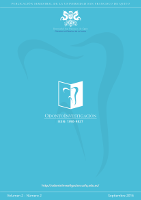Estudio experimental comparativo in vitro de la eliminación del barrillo dentinario en el tercio apical entre QMix y EDTA 17% con activación ultrasónica pasiva
Main Article Content
Abstract
The ability of Smear layer removal of two chelators agents EDTA 17% (EUFAR) and QMix (Dentsply Tulsa Dental, Tulsa, OK, USA), activated passive ultrasonic irrigation for 1 minute were evaluated. The samples were 22 premolars extracted single-rooted. Canals were instrumented with ProTaper rotatory technique and irrigated at each change of file with 5.25% sodium hypochlorite. The samples were split at 2 groups: A (QMix) B (EDTA 17%) both with PUI for 1 minute. Dental roots were hemisected longitudinally, and a half was taken to observation under 2000X magnification in scanning microscope. Twenty-two photographs were taken in the scanning electron microscope of the four experimental groups and were evaluated twice in random order by two observers with an interval of seven days without knowledge of previous result. The results indicate that the proportion of open dentinal tubules was 82.7% for QMix and 50.8% for the 17% EDTA. Currently the new irrigant QMix provides disinfection and removal of smear layer in one final irrigation, having successful results.
Article Details
References
Gutarts R, Nusstein J, Reader A, Beck M. InVivo Debridement Efficacy of UltrasonicIrrigationFollowingHand-RotaryInstrumentation in Human MandibularMolars. JOE. 2005;31(3):166-170.
Burleson A, Nusstein J, Reader A, Beck M.The In Vivo Evaluation ofHand/Rotary/Ultrasound Instrumentationin Necrotic, Human Mandibular Molars.JOE. 2007;33(7):782-787.
Hülsmann M, Heckendorff M, Lennon A.Chelating agents in root canal treatment:mode of action and indications for theiruse. Review. Int Endod J.2003;36(12):810-30.
Marques AA, Marchesan MA, Sousa-FilhoCB, Silva-Sousa YT, Sousa-Neto MD, Cruz-Filho AM. Smear Layer Removal andChelated Calcium Ion Quantification ofThree Irrigating Solutions. Braz Dent J.2006;17(4):306-309.
Mozo S, Llena C, Forner L. Review ofultrasonic irrigation in endodontics:increasing action of irrigating solutions.Med Oral Patol Oral Cir Bucal.2012;17(3):e512-6.
Wang Z, Shen Y, Haapasalo M. Effect ofsmear layer against disinfection protocolson Enterococcus faecalis-infected dentin. JEndod. 2013;39(11):1395-400.
Stojicic S, Shen Y, Qian W, Johnson B,Haapasalo M. Antibacterial and smear layerremoval ability of a novel irrigant, QMiX.International Endodontic Journal. 2011;45(4):363-71.
Dai L, Khechen K, Khan S, Gillen B,Loushine BA, Wimmer CE, Gutmann JL,Pashley D, Tay FR. The Effect of QMix, anExperimental Antibacterial Root CanalIrrigant, on Removal of Canal Wall SmearLayer and Debris. JOE. 2011;37(1):80-84.
Tang W, Wu Y, Smales RJ. Identifying andReducing Risks for Potential Fractures inEndodontically Treated Teeth. JOE.2010;36(4):609-617.
Uzunoglu E, Aktemur S, Uyanik MO,Durmaz V, Nagas E. Effect ofEthylenediaminetetraacetic Acid on RootFracture with Respect to Concentration atDifferentTimeExposures.JOE.2012;38(8):1110-3.
Sjögren U, Figdor D, Persson S, SundqvistG. Influence ofinfection at the time ofrootfilling on the outcome of endodontictreatment of teeth with apicalperiodontitis. International EndodonticJournal.1997;30(5):297-306.
de Gregorio C, Estevez R, Cisneros R,Heilborn C, Cohenca N. Effect of EDTA,Sonic, and Ultrasonic Activation on thePenetration of Sodium Hypochlorite intoSimulated Lateral Canals: An In Vitro Study.JOE. 2009;35(6):891-5.
van der Sluis L, Wu MK, Wesselink P.Comparison of 2 flushing methods used during passive ultrasonic irrigation of theroot canal. Quintessence international.2009;40(10):875-9.
Castelo-Baz P, Martín-Biedma B, CantatoreG, Ruíz-Piñón M, Bahillo J, Rivas-MundiñaB, Varela-Patiño P. In Vitro Comparison ofPassive and Continuous UltrasonicIrrigation in Simulated Lateral Canals ofExtracted Teeth. JOE. 2012; 38(5):688-91.
Kolosowski KP, Sodhi RN, Kishen A, BasraniBR. Qualitative analysis of precipitateformation on the surface and in thetubules of dentin irrigated with sodiumhypochlorite and a final rinse ofchlorhexidine or QMix. J Endod.2014;40(12):2036-40.
Wu L, Mu Y, Deng X, Zhang S, Zhou D.Comparison of the Effect of FourDecalcifying Agents Combined with 60_C3% Sodium Hypochlorite on Smear LayerRemoval. JOE. 2012;38(3):381-4.

